The Boysenberry Market is estimated to be valued at USD 540.5 million in 2025 and is projected to reach USD 949.9 million by 2035, registering a compound annual growth rate (CAGR) of 5.8% over the forecast period.
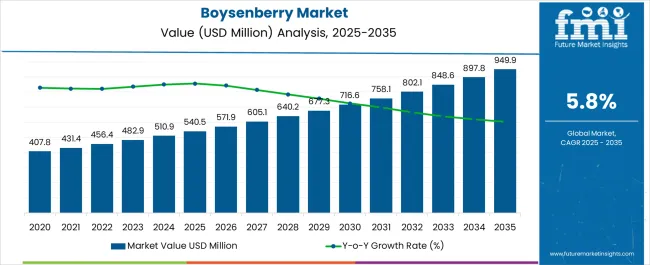
| Metric | Value |
|---|---|
| Boysenberry Market Estimated Value in (2025 E) | USD 540.5 million |
| Boysenberry Market Forecast Value in (2035 F) | USD 949.9 million |
| Forecast CAGR (2025 to 2035) | 5.8% |
The boysenberry market is witnessing steady growth as consumers increasingly seek nutrient rich fruits with strong antioxidant and vitamin content. Rising awareness about the health benefits of berry consumption, coupled with the popularity of natural ingredients in functional foods and beverages, is propelling demand.
Conventional cultivation continues to dominate as it supports large scale production volumes and cost efficiency, aligning with mainstream distribution requirements. Boysenberries are also being incorporated into household diets as fresh produce, frozen items, and processed goods such as jams and juices, reinforcing their role in everyday consumption patterns.
The expansion of retail networks across supermarkets, hypermarkets, and specialty stores has further boosted accessibility and brand visibility. The market outlook remains favorable as demand strengthens across both developed and emerging economies, driven by the convergence of health trends, product innovation, and widening consumer reach.
The market is segmented by Nature, Application, and Sales Channel and region. By Nature, the market is divided into Conventional and Organic. In terms of Application, the market is classified into Household, Beverages, Food, and Others. Based on Sales Channel, the market is segmented into Retail and Direct Sales. Regionally, the market is classified into North America, Latin America, Western Europe, Eastern Europe, Balkan & Baltic Countries, Russia & Belarus, Central Asia, East Asia, South Asia & Pacific, and the Middle East & Africa.

The conventional segment is projected to represent 64.20% of total revenue by 2025 within the nature category, positioning it as the leading contributor. This dominance is attributed to the scalability of conventional farming practices, wider distribution networks, and the ability to meet consistent consumer demand.
Conventional boysenberries offer cost advantages and greater supply stability compared to organic variants, making them attractive to both producers and retailers.
The segment’s accessibility to mass markets has solidified its dominance within the nature category.
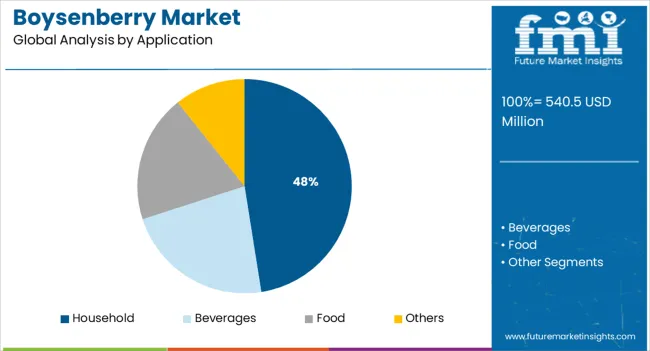
The household segment is expected to account for 47.50% of total revenue by 2025 under the application category, making it the most significant contributor. Demand has been fueled by rising household consumption of fresh and processed boysenberry products, supported by their versatility across multiple uses including juices, desserts, and preserves.
Increased focus on home based nutrition and healthier lifestyle choices has encouraged regular use of boysenberries in household diets.
This trend has reinforced the household segment as a primary driver of application growth.

The retail segment is anticipated to hold 58.30% of total market revenue by 2025 within the sales channel category, positioning it as the dominant distribution pathway. Expansion of organized retail outlets, growing penetration of supermarkets and hypermarkets, and the enhanced visibility of specialty fruit sections have bolstered retail sales.
Retail platforms provide consumers with convenient access, variety, and branded boysenberry offerings, further strengthening their role in driving sales.
The increasing alignment of consumer shopping habits with modern retail formats has ensured the continued leadership of this segment.
The value of the global market for Boysenberry expanded from USD 364.3 to USD 456.4 between 2020 and 2025, growing at a CAGR of 5.8%.
Customers are anticipated to be interested in purchasing natural items like boysenberries over the projected period due to a change in market trends. Positive effects on the expansion of the world Boysenberry market are anticipated from rising knowledge of functional foods and dietary supplements. Despite the promising prognosis, a number of factors could have an impact on how quickly the boysenberry market expands globally. Boysenberry use in combination with another extract may cause allergic reactions, which may be viewed as restrictive and have a negative impact on sales.
The global Boysenberry Market is forecast to grow at a solid CAGR of 5.8% from USD 540.5 Billion in 2025 to USD 949.9 Billion by 2035.
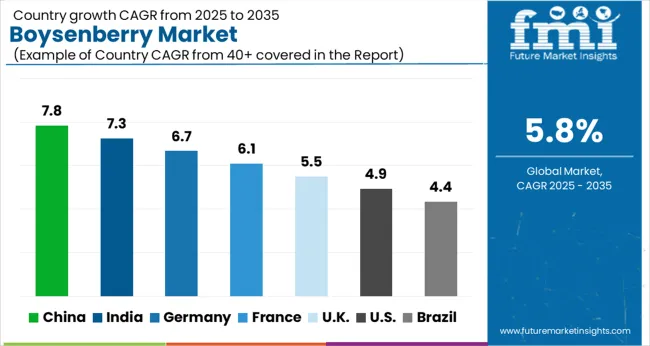
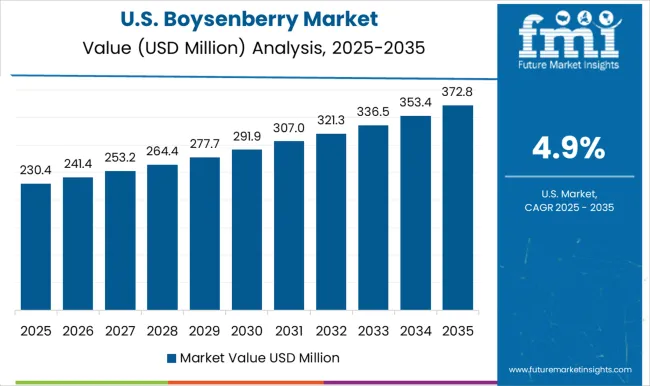
USA accounted for 31.4% of the North America market with a value of USD 540.5 Million in 2025. There are many factors that contribute to the United States' dominant position in the market for Boysenberry. The high quality of Boysenberry grown in the United States, combined with the country's strong infrastructure for transporting and distributing produce, has resulted in a thriving Boysenberry market. Additionally, the United States has a large population of consumers who are interested in Boysenberry, and the country's strong economy allows people to afford Boysenberry products.
The China Brewing Boiler Market will grow at 5.9% CAGR between 2025 and 2035. The Boysenberry market is developing rapidly in China. The fruit is becoming increasingly popular with consumers, who appreciate its unique flavor and texture. In addition, the Boysenberry is gaining a reputation for being a healthy choice, thanks to its high levels of antioxidants. This makes the fruit an attractive option for retailers and consumers alike.
The India Brewing Boiler Market will grow at 6.2% CAGR between 2025 and 2035. India is a major player in the global Boysenberry market. The country is the world's second-largest producer of the fruit, and its exports account for a significant share of the global market. India's position in the Boysenberry market is testament to the fruit's popularity among consumers around the world.
There is no doubt that the food and beverage industry will continue to be the largest consumer of boysenberry. The fruit has a unique flavor that is perfect for a wide range of products, from juices and jams to pies and pastries. Boysenberry growers and processors have responded to this demand by increasing production, and there is no indication that this trend will change in the near future.
There are a few reasons why Organic Boysenberry is preferred over other alternatives. First, the organic berries are grown without the use of synthetic pesticides, herbicides, or fertilizers. This means that they are healthier for both you and the environment. Second, the organic berries are also non-GMO, meaning that they have not been genetically modified in any way. Finally, organic berries tend to be more flavorful and nutritious than their conventionally-grown counterparts.
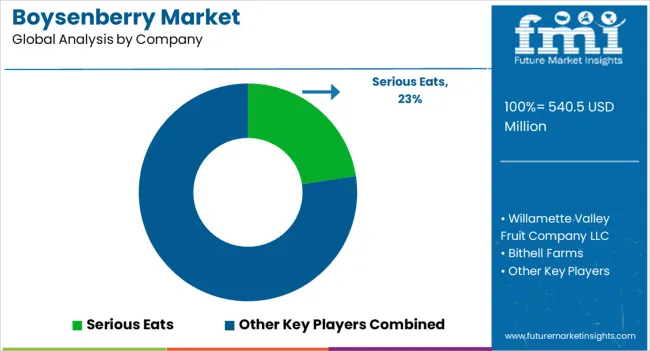
As the demand for Boysenberry continues to grow, so does the competition among suppliers. In order to stay ahead of the competition, it is important to understand the competitive landscape.
| Attribute | Details |
|---|---|
| Forecast Period | 2025 to 2035 |
| Historical Data Available for | 2020 to 2025 |
| Market Analysis | USD Million for Value and Units for Volume |
| Key Regions Covered | North America; Latin America; Europe; Asia Pacific; Oceania; MEA |
| Key Countries Covered | USA, Mexico, Canada, Germany, UK, France, Italy, Spain, India, Japan, China, South Korea, Australia, Argentina, Brazil, South Africa, UAE |
| Key Segments Covered | Nature, Application, Sales Channel, Region |
| Key Companies Profiled | Serious Eats; Willamette Valley Fruit Company LLC; Bithell Farms; Kerr Concentrates, Inc; Van Drunen Farms; LIONEL HITCHEN; Mountain Rose Herbs; Wai-West Horticulture Ltd Nelson; Amoretti; Ingrilli Citrus Inc. |
| Report Coverage | Company Share Analysis, DROT Analysis, Market Dynamics and Challenges, Strategic Growth Initiatives, Market Forecast, Competitive Landscape, |
| Customization & Pricing | Available upon Request |
The global boysenberry market is estimated to be valued at USD 540.5 million in 2025.
The market size for the boysenberry market is projected to reach USD 949.9 million by 2035.
The boysenberry market is expected to grow at a 5.8% CAGR between 2025 and 2035.
The key product types in boysenberry market are conventional and organic.
In terms of application, household segment to command 47.5% share in the boysenberry market in 2025.






Full Research Suite comprises of:
Market outlook & trends analysis
Interviews & case studies
Strategic recommendations
Vendor profiles & capabilities analysis
5-year forecasts
8 regions and 60+ country-level data splits
Market segment data splits
12 months of continuous data updates
DELIVERED AS:
PDF EXCEL ONLINE

Thank you!
You will receive an email from our Business Development Manager. Please be sure to check your SPAM/JUNK folder too.
Chat With
MaRIA